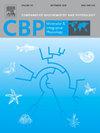评论:对水生动物进行嗅觉行为测定的最佳实践:比较生理学家指南
IF 2.1
3区 生物学
Q4 BIOCHEMISTRY & MOLECULAR BIOLOGY
Comparative Biochemistry and Physiology A-Molecular & Integrative Physiology
Pub Date : 2024-09-21
DOI:10.1016/j.cbpa.2024.111747
引用次数: 0
摘要
随着越来越多的生理学家开始将动物行为纳入他们的实验,尤其是在嗅觉行为研究领域,一些注意事项往往被忽视,部分原因是生理实验的设计和执行方式沿袭传统。在此,我们强调其中一些微妙但重要的注意事项,并说明为什么这些注意事项可能会影响从行为实验中收集到的结果。我们的目的是为提高方法的标准化程度提供有用的建议,以便在不同的实验和实验室中更容易地复制这些方法。我们将重点放在稿件材料与方法部分较少提及的领域,如饥饿、初步实验、适当的样本量以及选择气味剂进行测定时的注意事项。此外,我们强烈建议不要使用报警线索来产生行为反应,因为其化学性质/效力极不稳定。相反,我们建议使用纯化学物质(由一个已知分子组成),如氨基酸、胆汁酸或多胺,这些物质可在市场上买到,而且更容易以已知浓度配制。最后,我们强烈建议使用与环境相关浓度的这些气味剂。我们相信这些指导原则将有助于使这些检测标准化,并改善实验室内部和实验室之间的实验重复性。本文章由计算机程序翻译,如有差异,请以英文原文为准。

Commentary: Best practices for performing olfactory behavioral assays on aquatic animals: A guide for comparative physiologists
As more physiologists start to incorporate animal behavior into their experiments, especially in the olfactory behavior research field, some considerations are often overlooked, partly due to the inherited way that physiological experiments are traditionally designed and performed. Here we highlight some of these subtle but important considerations and make a case for why these might affect the results collected from behavioral assays. Our aim is to provide useful suggestions for increased standardization of methods so they can be more easily replicated among different experiments and laboratories. We have focused on areas that are less likely to be mentioned in the materials and methods section of a manuscript such as starvation, preliminary experiments, appropriate sample sizes and considerations when choosing an odorant for an assay. Additionally, we are strongly cautioning against the use of alarm cue to generate behavioral responses due to its highly unstable chemical properties/potency. Instead, we suggest using pure chemicals (made up of one known molecule) such as amino acids, bile acids, or polyamines that are commercially available and easier to make up in known concentrations. Lastly, we strongly suggest using environmentally relevant concentrations of these odorants. We believe these guidelines will help standardize these assays and improve replication of experiments within and between laboratories.
求助全文
通过发布文献求助,成功后即可免费获取论文全文。
去求助
来源期刊
CiteScore
5.00
自引率
4.30%
发文量
155
审稿时长
3 months
期刊介绍:
Part A: Molecular & Integrative Physiology of Comparative Biochemistry and Physiology. This journal covers molecular, cellular, integrative, and ecological physiology. Topics include bioenergetics, circulation, development, excretion, ion regulation, endocrinology, neurobiology, nutrition, respiration, and thermal biology. Study on regulatory mechanisms at any level of organization such as signal transduction and cellular interaction and control of behavior are also published.

 求助内容:
求助内容: 应助结果提醒方式:
应助结果提醒方式:


